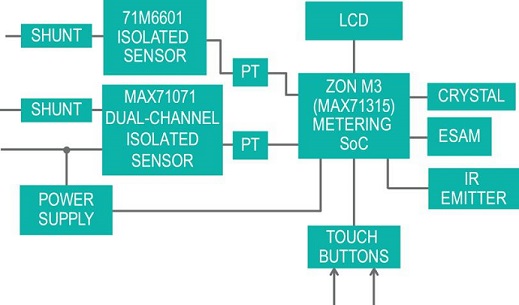A Cost-Saving Meter Design
Galaxy now has a new reference design for their electricity meter. They made several adjustments, but their most important change was the inclusion of a Maxim high-performance ZON™ M3 electricity metering (the MAX71315) system-on-chip (SoC) and the MAX710714 isolated sensors (Figure 3).

The new Galaxy design is so novel and cost saving because of the highly integrated ZON M3 SoC. This new Galaxy implementation does not require a current transformer (CT) or expensive copper bus bars. Isolation is provided by low-cost pulse transformers that form a bidirectional digital communication link between ZON M3 and the MAX71071 ADC and 71M6601 isolated sensor. The new design shaves more than 2.48 ¥ off their prior BOM (Table 1).
Table 1. Cost Savings for Galaxy Meter Design vs. Traditional Design
|
Components |
Traditional Design |
Galaxy Design |
Cost Savings by Design (%) |
|
Microcontroller |
Half-SoC + AFE |
Integrated electricity metering SoC (ZON M3) |
Traditional (10%) |
|
Clock |
1 RTC + 1 crystal |
1 crystal (integrated RTC) |
Galaxy (65%) |
|
Touch buttons (2) |
Switches |
Touch sensors (no cost) |
Galaxy |
|
Infrared (IR) |
External module |
Fully integrated |
Galaxy (30%) |
|
Power supply |
Dual (AFE + SoC) |
Single (SoC only) |
Galaxy (10%) |
|
Current and voltage sensors |
Shunt + CT + bus bars |
Shunt + isolated sensors* + pulse transformers |
Galaxy (30%) |
|
Isolation |
Optocouplers (2) |
Ensured by the isolated sensors (no cost) |
Galaxy |
*Note that the “isolated sensor” component here comprises the 71M6601 sensor and MAX71071, a dual 24-bit delta-sigma ADC with integrated amplifier and differential inputs, a precision voltage reference, a temperature sensor, and a supply voltage generator energized by power pulses provided by the ZON M3. This isolated sensor design offers immunity to magnetic tampering, and enhanced reliability.
Is That All?
To this point we have discussed how even small BOM cost savings can quickly add up to a significant savings on these meters. Good, but in reducing those costs Galaxy also had to meet the specifications defined by the CEPRI. So, while collaborating with Galaxy, Maxim optimized the ZON M3 SoC for the Chinese market. Because ZON M3 was already a flexible platform, it was easily customized for the requirements of the Chinese CEPRI requirements.
Timing in the meter. The CEPRI requires that the timing accuracy variation must be less than 0.5s per day at room temperature and rated operating voltage. Consequently, the meter’s real-time-clock (RTC) is another big piece of the equation. The ZON M3 metering SoC integrates an RTC with temperature compensation. Its accuracy across the whole temperature range of operation complies with the CEPRI specification. With the RTC integrated in the SoC, the solution saves on implementation, size and, of course, BOM costs.
Integrated security. ZON ensures the security of the meters by connecting to an embedded security access (ESAM) module. That module is interfaced via the ISO7816 protocol. That protocol is well known to the smartcard industry and operates with a specific UART. ZON integrates two of those dedicated UARTs.
Reliable data collection. To comply with this requirement, ZON integrates an infrared (IR) encoder and decoder that eliminate the typical extra IR receiver module needed to retrieve and collect the measured data from the meter.
Switching reliability. The CEPRI mandates two switch sensors on electricity meters. Mechanical switches generate reliability issues and require the casing of the meter to be drilled opened. ZON has two touch sensors that replace the obsolete and old-fashioned switch sensors and improve the user’s experience.
Collaboration + Integration = Higher Performance + Cost Reduction
Galaxy has already completed their reference design based on ZON M3 and will start promoting the design to the Chinese meter manufacturers in mid-2014.
This project has demonstrated how important it is for major semiconductors companies like Maxim to collaborate with local companies in order to understand the market and optimize the specifications of their products. I am very excited to be part of that initiative and to see how, together, we will change the landscape of the Chinese metering market. After all, it is not that often in your life that you are given the opportunity to save 155M ¥.
References
1. Estimated volume is based on 62.5M units, and growing, forecasted for China. See “China Powers Up Domestic Smart Meter Market,” IHS Technology, December 08, 2011, at https://technology.ihs.com/394928/china-powers-up-domestic-smart-meter-market
2. For more information about Suzhou Galaxy Camphol Technology Co. Ltd., go to http://www.szgc.com.cn/. Note that there is no English version of this website.
3. I use this term carefully and with all due respect to all utilities in China. In fact, besides the State Grid Corporation of China, there are actually two other minor utilities called South Grid and Rural Grid, both of which tend to follow the rules of State Grid.
4. See http://money.cnn.com/magazines/fortune/global500/2013/full_list/.
5. See IHS Technology, op. cit.
6. For more information, see http://www.epri.sgcc.com.cn/en/ .
7. For information on the ZON M3 electricity SoC, go to http://www.maximintegrated.com/MAX71315; for the MAX71071 and 71M6601 isolated sensors, go to http://www.maximintegrated.com/MAX71071 and http://www.maximintegrated.com/datasheet/index.mvp/id/7200
ZON is a trademark of Maxim Integrated Products, Inc.
About the Author
Gregory Guez holds a Master degree in Electronic Systems from Polytech’ Marseille (France). He joined Maxim in 2009 following the acquisition of Innova Card. He has been in charge of the company’s secure microcontroller business in Asia and lived in Hong Kong for 6 years. Gregory relocated to Irvine, California in Sept 2012 where he manages the business for the Energy Solutions Group at Maxim Integrated.






